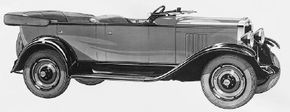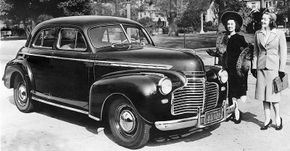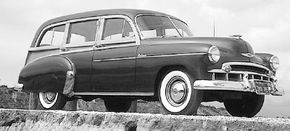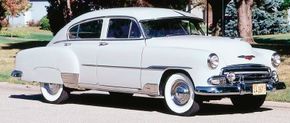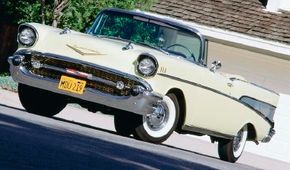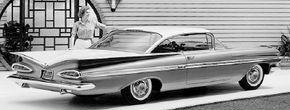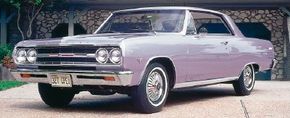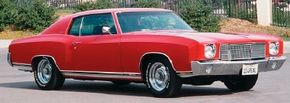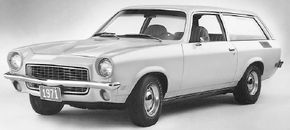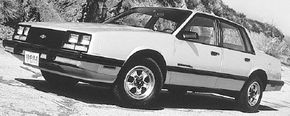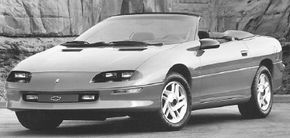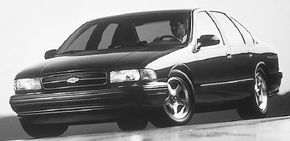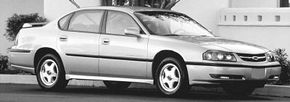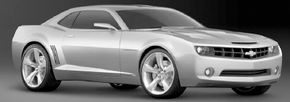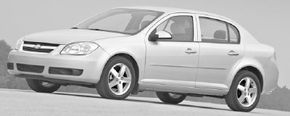The 1990 Camaros comprised RS and IROC coupes and convertibles with some extra standard features. Among the goodies: 16-inch wheel/tire package for IROCs, a torquier 3.1-liter V-6 with 140 bhp for RS, and a tilt steering wheel, driver-side airbag and GM "PASS-Key" antitheft ignition for all models. A deliberately shortened model year held production to just under 35,000.
Camaro's 1991 began in the spring of 1990. Z28s took over for IROCs. The reason? Dodge now sponsored the IROC series and owned rights to that name. At least Z coupes could be quicker now with a new 245-bhp 350 option, the extra power reflecting a switch to more-sophisticated sequential multipoint injection. The 305 also got that and rose to 230 bhp. Reworked front and back ends freshened all models, and Z28s wore a higher-flying rear spoiler that looked faintly ludicrous.
For all the recent additions to standard equipment, Camaro was still a bargain performance buy, ranging from $12,000 for the RS V-6 coupe to just under $21,000 for ragtop Z28. To Chevrolet's delight, sales more than tripled, '91 production soaring beyond 100,000. Volume then faded to 70,000, likely because a new Camaro was known to be coming for 1993.
The third generation thus closed out after '92 with only one further change: a $175 "Heritage Appearance" package to mark Camaro's 25th birthday. Available in white, red, or black, it involved only badges and some hood and decklid stripes. It was a feeble gesture, but at least Chevy didn't forget its ponycar's anniversary.
A ground-up fresh Camaro promised some new glory days. Arriving for '93 in base and Z28 coupe models, it was about the same size as its well-liked predecessor (wheelbase was unchanged) but more-sculptured and futuristically swoopy, patterned on the recent "California Camaro" show car -- and not that much more-subdued.
Yet the new fourth-generation design was unmistakably Camaro, carefully preserving hallowed appearance "cues" like tunneled headlamps, broad taillights, a low Vee'd nose, even optional T-tops for the coupe.
Despite added standard features, the '93 was only some 150 pounds heavier than previous Camaros. One reason was a lighter, yet stronger, unit body/chassis with steel-reinforced composite panels over a steel framework as on GM200 minivans and the small Saturn.
The nominal weight gain bode well for performance, especially on the Z28, which now packed a 350 LT1 V-8 with 275 bhp, 30 more than before. The base Camaro also muscled up via a new overhead-valve 3.4-liter V-6 with a creditable 160 horses. Transmission choices comprised standard five-speed manual for the base model, a new six-speed for Z28 (again borrowed from Corvette), and optional four-speed automatic for both.
Front suspension reverted to Detroit-traditional twin A-arms, though with unique geometry and premium gas-pressure, coil-over deCarbon shocks. The latter were also featured in back, where the live axle was now located by a torque rod and trailing arms.
Each end had a hefty stabilizer bar. Antilock brakes were standard, with rear discs on Z28. A tantalizing new option was RPO 1LE, an ultrastiff performance suspension package for Z28. It was "not recommended for street use" but worked wonders on the track.
With 70 more horses than a Mustang GT and a starting price on the right side of $17-grand, the '93 Z28 was immediately hailed as the new best buy in Detroit performance. That came from "buff books," who typically reported 0-60 at just over five seconds with manual.
For buyers of all stripes, Camaro appealed with standards like dual airbags, full instrumentation, and a good sound system (with even better ones available). Options were still fairly numerous but easier to comprehend, being grouped into sensible packages.
A deliberately slow "ramp-up" limited '93 Camaros to just 40,224, all coupes, but they were the tightest, most solid-feeling Camaros in history. Production then hit full stride to pass 125,000 for '94, when promised base and Z28 convertibles went on sale with standard power top; glass backlight; and a low, tidy "top stack."
Six-speed Z28s became a bit quicker that year thanks to shorter final gearing (3.42:1 vs. 2.73/3.23). Unhappily, their shifter acquired CAGS, the Computer Aided Gear Selection feature first used on Corvettes.
Electronic watchdogs "forced" a short-shift from 1st to 4th at certain speeds and throttle openings, a bit of nonsense prompted by government fuel-economy standards. But enthusiasts found that CAGS could be defeated by pulling a little wire, and many did pull it.
As ever, the torquey Z28 was a prodigious tire-smoker off-the-line, and a standard limited-slip differential was no substitute for modern traction control. Chevy finally obliged for '95 by offering the Corvette's ASR (Acceleration Slip Reduction) as a Z28 option.
ASR would restore lost grip by braking a spinning wheel and/or throttling back on engine power as needed -- a boon for wet-road control. And when the road was dry, you could switch it off if you wanted. Street racers loved that.
Though a new Mustang had galloped away with the ponycar market, Camaro mostly held its own for 1995, slipping to 110,595. Arriving late that year was a stronger "3800" V-6 option for base models sold in California. This became standard for all '96s, bringing a useful 40 extra horsepower and 25 more pound-feet of torque over the displaced 3.4. With that, a base Camaro could at least keep up with a Z28 on winding roads, though not on a dragstrip, of course.

